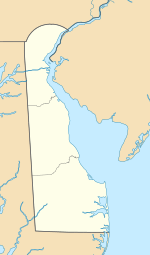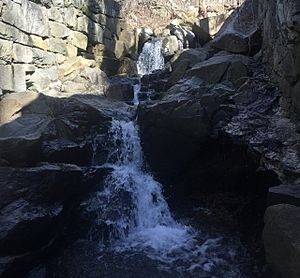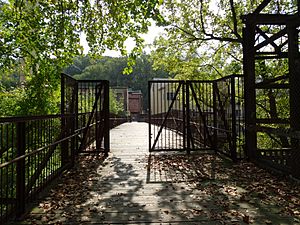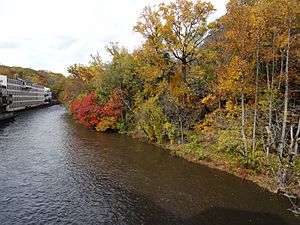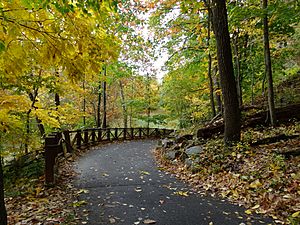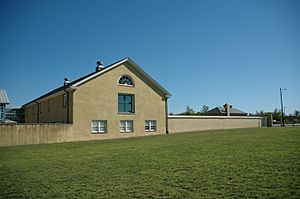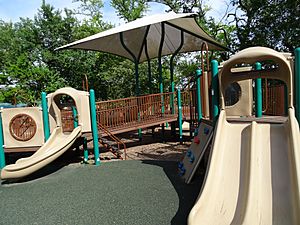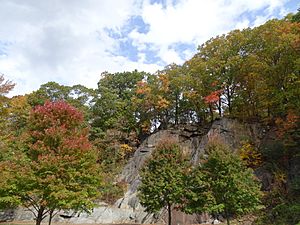Alapocas Run State Park facts for kids
Quick facts for kids Alapocas Run State Park |
|
|---|---|

Alapocas Run Quarry
|
|
| Location | New Castle, Delaware, United States |
| Area | 415 acres (168 ha) |
| Named for | Alapocas Run, tributary of Brandywine Creek |
| Governing body | Delaware Department of Natural Resources and Environmental Control |
| Website | Alapocas Run State Park |
Alapocas Run State Park is a fun state park located in Wilmington, Delaware, USA. It sits along the beautiful Brandywine Creek and a smaller stream called Alapocas Run. This park is open all year and covers about 415 acres.
A lot of the park's land was saved in the early 1900s by a man named William Poole Bancroft. He wanted to make sure Wilmington had green spaces as it grew. The park also has a cool old building called the Blue Ball Barn. It was a dairy barn built in 1914 by Alfred I. du Pont for his huge Nemours estate.
Alapocas Run State Park offers many things to do. You can find walking trails, sports fields, and playgrounds for kids. One of the most exciting features is a rock climbing wall! This wall is part of an old quarry (a place where stone was dug out). The quarry is also used for school programs to teach about earth sciences.
Contents
Discovering Alapocas Run's Past
Alapocas Run started as a city park called Alapocas Woods in 1910. It was about 123 acres back then. A wealthy businessman, Alfred I. du Pont, was building his Nemours estate. Another important person, William Poole Bancroft, convinced du Pont's company to give some land to Wilmington. Bancroft also gave some of his own land to the city.
William Poole Bancroft was not just a businessman; he loved nature and helped people. He had already helped create other city parks. He wanted to protect the beautiful Brandywine area. His own family's mills were right across the river. Bancroft and du Pont even paid together to pave Alapocas Road, which separated the park from the Nemours estate.
Over the years, the park grew to 145 acres. Much of it was covered in old trees. It also had the remains of a granite quarry. This quarry was active from 1870 to 1938. Stone from here was used to build famous local landmarks. These include the walls in Brandywine Park and the tower in Rockford Park.
In 1998, Alapocas Run became part of a state park system. It joined with other city parks to form Wilmington State Parks.
In 1999, the state worked on a big project called the Blue Ball Project. This project improved roads and created more parkland. It bought about 152 acres from the Nemours Foundation for open space. The Nemours Foundation also protected 70 acres of old woods near the Nemours Alfred I. duPont Hospital for Children.
The new Alapocas Run State Park officially opened in 2002. It combined the old parkland with the newly bought open spaces. Plans were made to add more park features, like fixing up the historic Blue Ball Barn.
In 2015, the Nemours Foundation gave another 46 acres to expand the park even more.
Exploring the Blue Ball Barn
The Blue Ball Barn is the park's visitor center and main office. Inside, you can see the Delaware Folk Art Collection. This exhibit has over 120 artworks by 50 local artists. It shows off the state's rich artistic history.
The first floor of the barn has exhibits about farming history. You can learn how dairy technology changed over time. The barn also has rooms you can rent for meetings or events.
The state decided to save and reuse this historic building as part of the park. Alfred I. du Pont built the barn in 1914. It was a very modern dairy barn for its time. The barn and farm provided food for the Nemours estate from 1914 to 1943. After that, a family leased the farm and sold dairy products to others until 1977. Most of the other farm buildings were torn down after 1977, but the barn remained.
The barn got its name from an old tavern that was nearby in the late 1700s. The tavern had a pole with a large blue ball. If the ball was at the top, it meant stagecoaches should stop for passengers. If it was lowered, the stagecoach would just pass by. This was a way to signal drivers who couldn't read.
Fun Activities at the Park
A main road, U.S. Route 202, splits the park into two parts. The eastern part is for active sports and games. The larger western part is for enjoying nature and quiet activities.
Eastern Park: Sports and Play
The eastern section has three sports fields. You can play team sports like lacrosse, soccer, and rugby here if you have a permit. It also has the amazing 26,000-square-foot Can-Do Playground. This playground was designed to be fully accessible for kids with disabilities. Local Rotary Clubs helped fund and build it, and it opened in 2007.
Near the playground, there's a picnic area with outdoor grills. The eastern part of the park also connects to the Rock Manor Golf Course through trails. This public golf course opened in 1921. It was redesigned and reopened in 2008 as part of the Blue Ball Project.
Western Park: Trails and Nature
The western part of the park has most of the hiking and biking trails. It includes over 2 miles of the Northern Delaware Greenway Trail. This trail is part of the longer East Coast Greenway. It connects Alapocas Run to other parks like Bellevue State Park and Fox Point State Park.
The Alapocas Woods Trail is another path in this section. It's about 0.7 miles long, with a 0.3-mile loop. This trail is a great place to see the park's many pawpaw trees. The old granite quarry walls are now set up for rock climbing and rappelling.
Nearby State Parks
If you enjoy Alapocas Run State Park, you might like these other parks within 30 miles:
- Auburn Valley State Park (New Castle County)
- Bellevue State Park (New Castle County)
- Brandywine Creek State Park (New Castle County)
- Fort Delaware State Park (New Castle County)
- Fort DuPont State Park (New Castle County)
- Fort Mott State Park (New Jersey)
- Fort Washington State Park (Pennsylvania)
- Fox Point State Park (New Castle County)
- Lums Pond State Park (New Castle County)
- Marsh Creek State Park (Pennsylvania)
- Norristown Farm Park (Pennsylvania)
- Parvin State Park (New Jersey)
- Ridley Creek State Park (Pennsylvania)
- Wilmington State Parks (New Castle County)
- White Clay Creek Preserve (Pennsylvania)
- White Clay Creek State Park (New Castle County)


